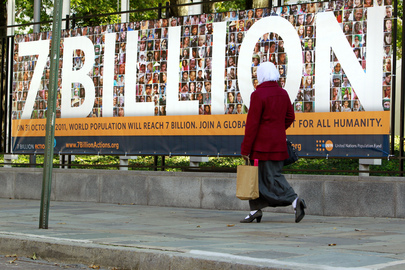Feeling Claustrophobic isn't it???? Crowded MRTS trains and city buses, people milling about with no space even for an errant elbow in T.Nagar, long-queues everywhere even for buying groceries, clearing-up of the only wet-land habitat in Chennai near Pallikaranai for housing (with ever-booming Real Estate businesses) and for waste-disposal, etc. all reminds us one thing. The strain that the superfulous population is placing on a fragile planet! With the world population clock ticking seven billion, how is India going to experience this scenario of opportunities and challenges???
 |
| SEVEN BILLION: Mark of celebration or a catastrophe?? |
The arival of baby Nargis, the world's most symbolic seven billionth person, on monday near Lucknow was greeted with much merriment, fanfare and publicity. Whether we deserve deserve to pat ourselves on the back on reaching this milestone is a matter of debate. With 1.21 billion people and a decadal growth rate of 17.64 percent (2011 census), India adds more people that anyother nation in the world and the individual population of some of its states is equal to the population of many countries! We dream for "Super Power India 2020", but nothing can prevent the 2025 reality of India overtaking China to become the world's most populous country. So, it is unsubtle that our generation would face a world of 'contradictions' - plenty of food, but still a billion people going to bed hungry every night; many people enjoying luxuries, but still many are impoverished.
India can take advantage of the demographic divident of a "youth bulge" - 50 percent of our population is under the age of 25 - meaning, more labour force (with increasing women working class), a precious human resource that other nations are deprived of. But the UNPF (United Nations Population Fund) has warned that this opportunity clock is ticking fast. The youth bulge witnessed a peak in 2000, and its effects will be felt only until 2025, when the number of dependents, aided by decreasing mortality rates, is bound to increase. So, we need to keep our young population employed, but also need plan for a ageing population just like China in the present decades. But the proliferation of old-age homes and deteriorating responsibilty of younger generations towards the senior citizens worries me indeed, considering the above prediction.
I am extremely happy that the seven billionth person, baby Nargis, is a girl and born in Uttar Pradesh, where the arrival of baby girls is not often celebrated. The state's capital Lucknow, has one of its worst sex ratios - just 899 girls to 1,000 boys, a sign of endemic discrimination and widespread practice of female foeticide. The 2011 census reveals India's wickedest child sex ratio - just 914 girls for every 1,000 boys as compared to 927 in 2001. India's maternal mortality ratio is pegged at 212 per 1,00,000 live births, which is still high in spite of continued efforts in the recent five-year plans. Fifty new-borns among every 1,000 also die. Though we improved notably, the overall picture of Indian demographics is grim.
We also have two contrasting demographics within ourselves. Some states like Tamil Nadu, Andra Pradesh, Karnataka and Kerala have already achieved favourable sex ratios and the replacement level fertility of 2.1 children per women required to initiate the process of population stabilisation, while others like Bihar, Uttar Pradesh, Rajastan, etc. have a long way to go.
So, the exploding population poses several threats and challenges to India than the opportunities offered. The "vanishing" girl population and the shaming numbers underscore the fact that the laws have done nothing to curb female foeticide or change the cultural preference for a boy child. The high birth rates in the states with poor HDI (Human Development Index) and lack of support systems for the aged posses major challenges. The planners must focus on some key areas - equitable access to safe water, food, healthcare, shelter, sanitation, education and employment. At the same time, balancing these against scarse resources, safeguarding the environment and protecting against the climate change, is imperative. There is a need for a paradigm shift in policies, looking for a more holistic and sustainable progress.


